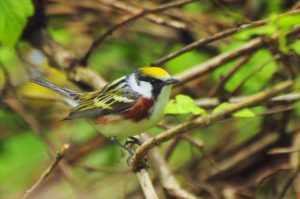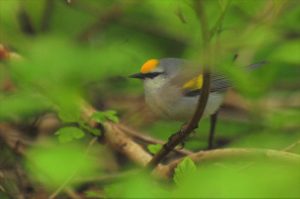Photography courtesy of Lowell Washburn, all rights reserved.
For Iowa birding enthusiasts, it just doesn’t get any better than the month of May. The final curtain call of the spring migration, it’s a time when everything seems to arrive at once. Spring migrants come in all colors, shapes and sizes. But of the more than 200 bird species that will nest in or migrate through our state, perhaps no single group presents a greater challenge to observe or correctly identify than that intriguing collection of tiny birds known as wood warblers. Photographing these energetic little travelers is a tough proposition – an outdoor task that on some days, seems nigh onto impossible. Most warblers are hyper-active to the third degree and rarely stay in the same spot for more than a second or two. Most only measure about four inches in length and, following a really big meal, weigh-in at around a third of an ounce. Attempting to photograph them usually means getting a lot of really good pictures of the empty twig where a warbler just was.
Although hundreds of thousands of warblers pass through Iowa each spring, most folks – even those who enjoy the outdoors – are totally unaware of their presence. Warblers migrate at night and spend their days in deep cover refueling on insects. For many species, the time spent in Iowa is brief. Most will nest in the wilderness forests of northern Canada and still have a long way to travel. For those outdoor enthusiasts who would cash in on this year’s migration, there is no time to waste.
Trip Tips: Whether you choose to observe warblers through a set of good binoculars or a camera lens, there are some basic tactics that can put you on the fast track to success. The first is to put yourself in the right place at the right time. Start by looking for moist woodlands containing thick green understory at the ground level and a healthy canopy of tall, mature trees over the top. Warblers feed almost entirely on insect life. My [and the warblers’] favorite types of insect harboring understory are dense patches of dogwood, gooseberry, and ninebark. Oaks are a preferred canopy tree.
Although not a requirement, I prefer to already be in the woods at first light. It’s the coolest part of the day and both warblers and their prey are likely to be moving at their slowest pace. Arriving at a likely looking spot, I take a stand and then listen and watch. Once you hear or see activity, slowly move to the spot and dig in. Wearing dark camo’ and remaining completely motionless will greatly increase your warbler close encounters. Staying in one spot beats moving around. Be patient and let the birds come to you. Go after them and most these shy little creatures will just slip deeper into the thick understory; usually long before you are even aware of their presence.
Once you get the hang of it, “sitting tight” can result in incredible outdoor shows as warblers sing, preen, chase insects, and interact with other woodland bird species – often at a distance of mere feet. Today provided a classic example. After sitting in one spot for only twenty or thirty minutes, I watched as 5 species of warblers [Magnolia, Wilson’s, Nashville, northern waterthrush and yellowthroats] plus a least flycatcher, two wrens, and several white-throated sparrows hopped, chased, perched, and preened – all within 20 feet of my position. Fascinating!! If I had just walked through that same area, I may or may not have seen any of those birds.
One last tip. Don’t forget to bring the bird book. As stated earlier, warbler identification can present a daunting challenge. With more than thirty species to choose from, even the experts get confused. My advice is to not get too hung up on identification. No one needs to know the Latin name of every creature in the forest. I recommend that you just sit back, relax and enjoy the show. You don’t have to be a trained ornithologist to have fun watching wild birds. You just need to be there.













 Tom Cope
Tom Cope Sue Wilkinson
Sue Wilkinson Susan Judkins Josten
Susan Judkins Josten Rudi Roeslein
Rudi Roeslein Elyssa McFarland
Elyssa McFarland Mark Langgin
Mark Langgin Adam Janke
Adam Janke Joe Henry
Joe Henry Kristin Ashenbrenner
Kristin Ashenbrenner Joe Wilkinson
Joe Wilkinson Dr. Tammy Mildenstein
Dr. Tammy Mildenstein Sean McMahon
Sean McMahon